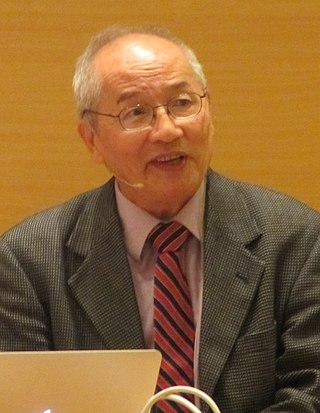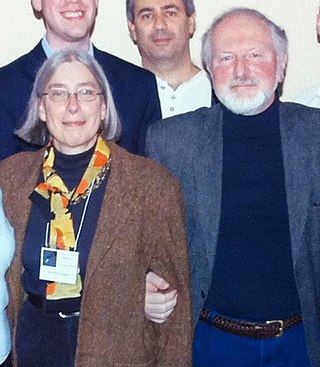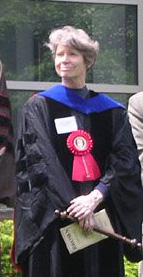Related Research Articles

The American Astronomical Society is an American society of professional astronomers and other interested individuals, headquartered in Washington, DC. The primary objective of the AAS is to promote the advancement of astronomy and closely related branches of science, while the secondary purpose includes enhancing astronomy education and providing a political voice for its members through lobbying and grassroots activities. Its current mission is to enhance and share humanity's scientific understanding of the universe as a diverse and inclusive astronomical community.

Planetary geology, alternatively known as astrogeology or exogeology, is a planetary science discipline concerned with the geology of celestial bodies such as planets and their moons, asteroids, comets, and meteorites. Although the geo- prefix typically indicates topics of or relating to Earth, planetary geology is named as such for historical and convenience reasons; due to the types of investigations involved, it is closely linked with Earth-based geology. These investigations are centered around the composition, structure, processes, and history of a celestial body.

Frank Hsia-San Shu was a Chinese-American astrophysicist, astronomer, and author. He served as a Professor Emeritus at the University of California, Berkeley and University of California, San Diego. He is best known for proposing the density wave theory to explain the structure of spiral galaxies, and for describing a model of star formation, where a giant dense molecular cloud collapses to form a star.

Peter Goldreich is an American astrophysicist whose research focuses on celestial mechanics, planetary rings, helioseismology and neutron stars. He is the Lee DuBridge Professor of Astrophysics and Planetary Physics at California Institute of Technology. Since 2005 he has also been a professor at the Institute for Advanced Study in Princeton, New Jersey. Asteroid 3805 Goldreich is named after him.

David Nathaniel Spergel is an American theoretical astrophysicist and the Emeritus Charles A. Young Professor of Astronomy on the Class of 1897 Foundation at Princeton University. Since 2021, he has been the President of the Simons Foundation. He is known for his work on the Wilkinson Microwave Anisotropy Probe (WMAP) project. In 2022, Spergel accepted the chair of NASA's UAP independent study team.

Maria T. Zuber is an American geophysicist who is the vice president for research at the Massachusetts Institute of Technology, where she also holds the position of the E. A. Griswold Professor of Geophysics in the Department of Earth, Atmospheric and Planetary Sciences. Zuber has been involved in more than half a dozen NASA planetary missions aimed at mapping the Moon, Mars, Mercury, and several asteroids. She was the principal investigator for the Gravity Recovery and Interior Laboratory (GRAIL) Mission, which was managed by NASA's Jet Propulsion Laboratory.

Bruce Thomas Draine is an American astrophysicist. He is Professor of Astrophysical Sciences at Princeton University.

Martha Patricia Haynes is an American astronomer who specializes in radio astronomy and extragalactic astronomy. She is the distinguished professor of arts and sciences in astronomy at Cornell University. She has been on a number of high-level committees within the US and International Astronomical Community, including advisory committee for the Division of Engineering and Physical Sciences of the National Academies (2003–2008) and Astronomy and Astrophysics Decadal Review. She was a vice-president of the executive committee of the International Astronomical Union from 2006–2012, and was on the board of trustees of Associated Universities Inc from 1994 until 2016, serving two terms as board chair and one year as interim president.
James Bailey "Jim" Kaler was an American astronomer and science writer.

Reta F. Beebe is an American astronomer, author, and popularizer of astronomy. She is an expert on the planets Jupiter and Saturn, and the author of Jupiter: The Giant Planet. She is a professor emeritus in the Astronomy Department at New Mexico State University and 2010 winner of the NASA Exceptional Public Service medal.

Carle McGetchin Pieters is an American planetary scientist. Pieters has published more than 150 research articles in peer-reviewed journals and was co-author of the book Remote Geochemical Analyses: Elemental and Mineralogical Composition along with Peter Englert. Her general research efforts include planetary exploration and evolution of planetary surfaces with an emphasis on remote compositional analyses.
Marc Kamionkowski is an American theoretical physicist and currently the William R. Kenan, Jr. Professor of Physics and Astronomy at Johns Hopkins University. His research interests include particle physics, dark matter, inflation, the cosmic microwave background and gravitational waves.
Sarah T. Stewart-Mukhopadhyay is an American planetary scientist known for studying planet formation, planetary geology, and materials science. She is a professor at the University of California, Davis in the Earth and Planetary Sciences Department. She was a professor at Harvard University Department of Earth and Planetary Sciences from 2003 to 2014.

Stephen J. Mackwell is a researcher in geophysics, specializing in laboratory-based studies of the physical, chemical and mechanical properties of geological materials. He is also interested in the transport of fluid components in mantle and crustal rocks on the microscopic and macroscopic scales, and on the effects of such components on mechanical properties. He has authored or co-authored over 80 articles in international scientific journals and is an editor of a book on comparative climatology of terrestrial planets published by the University of Arizona Press.
Anita L. Cochran is an American astronomer, planetary scientist, and senior research scientist at the University of Texas at Austin. She is also the assistant director for research support at the McDonald Observatory. She focuses on the study of primitive bodies in the solar system and the composition of comets.
Linda Siobhan Sparke is a British astronomer known for her research on the structure and dynamics of galaxies. She is a professor emerita of astronomy at the University of Wisconsin–Madison, and Explorers Program Scientist in the NASA Astrophysics Division.
Ilaria Pascucci is an Italian-American astrophysicist and planetary scientist known for her research on exoplanets, protoplanets, the formation of planets, and protoplanetary disks, using a combination of theory, simulation, and observation. Pascucci is a professor and associate department head in the Lunar and Planetary Laboratory at the University of Arizona.
Kathleen DeGioia Eastwood is an American astronomer known for her research on the formation and evolution of massive stars, and for her work on undergraduate education in astronomy. She is a professor emerita of astronomy and planetary science at Northern Arizona University.
References
- ↑ "Emeritus Faculty". Department of Geology and Planetary Science - University of Pittsburgh. Retrieved 6 December 2010.
- ↑ Who's who in Frontiers of Science and Technology . Marquis Who's Who. 22 May 1985. ISBN 9780837957029 – via Internet Archive.
Hapke, bruce william 1931.
- 1 2 3 4 5 "2001 Prize Winners - DPS" . Retrieved 6 December 2010.
- ↑ "Department of Geology and Planetary Science". University of Pittsburgh. Archived from the original on 6 February 2005. Retrieved 6 December 2010.
- ↑ "Emeritus Faculty". Department of Geology and Planetary Science - University of Pittsburgh. Retrieved 6 December 2010.
- ↑ "AAS Fellows". AAS. Retrieved 28 September 2020.
- ↑ Anand, Mahesh; Lawrence A. Taylor; Mikhail A. Nazarov; J. Shu; H.-K. Mao; Russell J. Hemley (May 4, 2004). "Space Weathering on Airless Planetary Bodies: Clues from the Lunar Mineral Hapkeite". Proceedings of the National Academy of Sciences of the United States of America. National Academy of Sciences. 101 (18): 6847–6851. Bibcode:2004PNAS..101.6847A. doi: 10.1073/pnas.0401565101 . JSTOR 3372016. PMC 406430 . PMID 15118081.
- ↑ "PSRD:: Discovery of hapkeite" . Retrieved 6 December 2010.